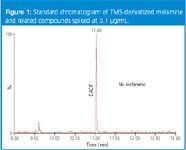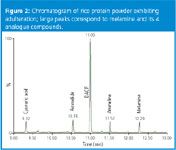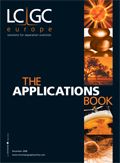GC–MS Screening for Melamine Adulteration in Baby Formula and Dairy Products
The Application Notebook
Melamine is an industrial chemical with a high nitrogen content that can cause kidney stones and lead to renal failure. In some instances, melamine has been added to baby formula and dairy products as a substitute for protein. This paper presents an efficient and definitive gas chromatography–mass spectrometry (GC–MS) method to identify melamine and related compounds based on the released US Food and Drug Administration (FDA) method.
William Goodman1 and James Neal-Kababick,2 1PerkinElmer Inc., Waltham, Massachusetts, USA, 2 Flora Research Laboratories, Grants Pass, Oregon, USA.
Introduction
Melamine is an industrial chemical with a high nitrogen content that can cause kidney stones and lead to renal failure. In some instances, melamine has been added to baby formula and dairy products as a substitute for protein. This paper presents an efficient and definitive gas chromatography–mass spectrometry (GC–MS) method to identify melamine and related compounds based on the released US Food and Drug Administration (FDA) method.
Experimental
A 0.5 g sample is sonicated for 30 minutes in 20 mL of 10:40:50 (by volume) solution of diethylamine (DEA), water and acetonitrile to extract the melamine. The sample is centrifuged for 10 minutes at 3500 RPM to settle fine particulates from the sample matrix. The supernatant fluid is filtered and evaporated. The dry sample is reconstituted in an autosampler vial with 200 μL of pyridine and 100 μL of a 0.5 μg/mL internal sample solution. Melamine and related compounds are converted to trimethylsilyl (TMS) derivatives with the reagent consisting of bis(trimethylsilyl)trifluoracetamide (BSTFA) with 1% trimethylchlorosilane (TMCS). 200 μL of this solution is added and the sample is incubated at 70 °C for 45 minutes.
A PerkinElmer EcoAnalytix Melamine Analyser, based on Clarus GC–MS technology with a PerkinElmer Elite-5MS column (30 m × 0.25 mm × 0.25 μm) was used to analyse the sample. The GC used a programmable split/splitless injector with a PSSI port type, isothermal at 280 °C. The 0.5 μL injection volume matched the solvent vapour expansion volume with the inner volume of the 2 mm i.d. inlet liner. The mass spectrometer used a 280 °C GC inlet line temperature, 230 °C ion source temperature, 50–450 u full scan range and 0.2 second full scan time.

Figure 1
Results
The data quality checks used in this method include analysis of the pyridine solvent and derivatization reagent (solvent blank); analysis of the unspiked solvent (method blank); and a matrix spike-sample at both the high and low levels. Figure 1 shows a chromatogram of the low standard. A number of protein materials were analysed including the rice-protein samples shown in Figure 2. Melamine was detected at a low level compared to the analogue and matrix peaks. The optimized GC method presented here completely resolved melamine from the surrounding peaks, allowing for easy identification. Mass spectral comparison between standard spectra and experimental spectra of melamine confirmed the peak identity.

Figure 2
Conclusion
Recent instances of adulteration of baby formula and dairy products with melamine and related compounds have created the need for more detailed testing of protein-based food and feed ingredients. This paper presents sample-preparation and instrumentation techniques for the analysis of melamine and related compounds. The PerkinElmer EcoAnalytix Melamine Analyser detects adulteration of the low-level spike in full-scan mode, demonstrating exceptional sensitivity for routine screening of complex matrices.

PerkinElmer Inc.
940 Winter Street, Waltham, Massachusetts 02451 USA
tel. +1 800 762 4000 or +1 203 925 4602
fax +1 203 944 4904
Website: www.perkinelmer.com

Identifying and Rectifying the Misuse of Retention Indices in Gas Chromatography
October 31st 2024LCGC International spoke to Phil Marriott and Humberto Bizzo about a recent paper they published identifying the incorrect use of retention indices in gas chromatography and how this problem can be rectified in practice.
Analytical Challenges in Measuring Migration from Food Contact Materials
November 2nd 2015Food contact materials contain low molecular weight additives and processing aids which can migrate into foods leading to trace levels of contamination. Food safety is ensured through regulations, comprising compositional controls and migration limits, which present a significant analytical challenge to the food industry to ensure compliance and demonstrate due diligence. Of the various analytical approaches, LC-MS/MS has proved to be an essential tool in monitoring migration of target compounds into foods, and more sophisticated approaches such as LC-high resolution MS (Orbitrap) are being increasingly used for untargeted analysis to monitor non-intentionally added substances. This podcast will provide an overview to this area, illustrated with various applications showing current approaches being employed.